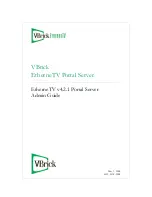
Chapter 7 Storage
Media Server User’s Guide
160
7.6 Storage Technical Reference
This section provides some background information about the topics covered in this chapter.
7.6.1 Volumes and RAID
A volume is a storage area on a disk or disks. You can create volumes on the internal disks and
external disks attached to the USB port(s). You can spread a volume across internal disks but not
between internal and external disks.
RAID (Redundant Array of Independent Disks) or JBOD is the storage method that the NSA uses.
The storage method you use depends on how many disks you have and how many volumes you
want to create. It’s important that you consider this carefully as all data is deleted when you re-
create a volume.
Note: Back up your data before deleting or re-creating a volume!
Below is a table that summarizes some attributes of the various RAID levels as supported on the
NSA. For capacity and storage efficiency, “S” is the size of the smallest drive in the array, and “N” is
the number of drives in the array.
Storage efficiency assumes all drives are of identical size.
Performance rankings are approximations.
7.6.2 Choosing a Storage Method for a Volume
The following is a guide to help you choose a storage method for the various number of disks
supported on the NSA. See
for theoretical background on JBOD and the
RAID levels used on the NSA. Typical applications for each method are also shown there.
One Disk
If you only have one disk, you must use JBOD. All disk space is used for your data - none is used for
backup. If the disk fails, then you lose all the data on that volume (disk). You can add another disk
to your one-disk JBOD volume later without having to re-create shares, access rights, and so on.
Alternatively, you could create a different JBOD volume if you install a second disk. (and create new
shares, access rights and so on).
Table 27
RAID Quick Comparison
RAID Level
0
1
Number of Disks
2
2
Capacity
S*N
S*N/2
Storage Efficiency
100%
50%
Fault Tolerance
None
YYYY
Availability
Y
YYYY
Read Performance
YYYY
YYY
Write Performance
YYYY
YYY
Summary of Contents for NSA series
Page 4: ...Contents Overview Media Server User s Guide 4 ...
Page 14: ...Table of Contents Media Server User s Guide 14 ...
Page 15: ...15 PART I User s Guide ...
Page 16: ...16 ...
Page 20: ...Chapter 1 Getting to Know Your NSA Media Server User s Guide 20 ...
Page 50: ...Chapter 3 Web Configurator Basics Media Server User s Guide 50 ...
Page 114: ...Chapter 4 Tutorials Media Server User s Guide 114 5 Click Get Certificate ...
Page 134: ...Chapter 4 Tutorials Media Server User s Guide 134 ...
Page 135: ...135 PART II Technical Reference ...
Page 136: ...136 ...
Page 140: ...Chapter 5 Status Screen Media Server User s Guide 140 ...
Page 150: ...Chapter 6 System Setting Media Server User s Guide 150 ...
Page 164: ...Chapter 7 Storage Media Server User s Guide 164 ...
Page 286: ...Chapter 13 Using Time Machine with the NSA Media Server User s Guide 286 ...
Page 344: ...Chapter 19 Troubleshooting Media Server User s Guide 344 ...
Page 350: ...Appendix A Legal Information Media Server User s Guide 350 ...
















































